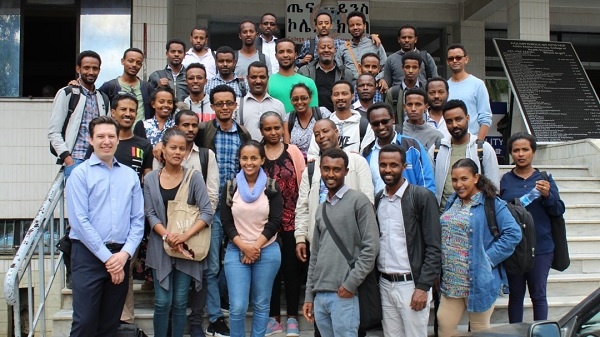
The MIT Humanitarian Supply Chain lab led a blended supply chain management course with Addis Ababa University.
What might pharmacy students at Addis Ababa University learn from a Massachusetts Institute of Technology (MIT) supply chain course? The answer is quite a lot.
Research Scientist Alex Rothkopf of the MIT Humanitarian Supply Chain Lab recently taught a blended course to the Addis Ababa University (AAU) School of Pharmacy in Ethiopia. “I’ve never taught pharmaceutical students,” he says. “They’re used to a different way of learning.”
Learning about analytics in global health supply chains
The entire course, adapted from the MITx MicroMasters Program in Supply Chain Management and with support from John Snow Inc., took 16 weeks and was composed of both online and in-person instruction. Students would complete a six-week block of online learning followed by two weeks of in-person lab sessions with Rothkopf at AAU. The online component included a forum where students could ask questions and discuss the lectures. The first participants in the course were 55 pharmaceutical supply chain students and AAU faculty, who went through it as students in a “train-the-trainer” program, in order to learn the material and concepts to use in their own teaching.
With an average of four or five years in the pharmaceutical field, the group “had a lot of business experience,” says Rothkopf. Despite most learners having no formal training in supply chain management, they “knew the problems they see in the field. They had to do inventory decisions. They had to do capacity-management decisions. They had to do network design decisions.” And so they immediately saw how mastering supply chain analytics could help them; the potential to solve real-world problems they’d faced many times before inspired learners to master the curriculum.
Beza Negash is an assistant lecturer in the School of Pharmacy at AAU and is also a master’s student in supply chain management at AAU. She was in the first cohort of AAU instructors to take the blended course.
Beza* says the pharmaceutical supply chain in Ethiopia suffers from a lack of inventory management and poor network design, as well as a weak distribution system and weak fleet management. “We face major challenges,” she adds, such as overstocking, understocking, and product expiration, among others.
With online learning, although issues like reliable internet connectivity can be a problem in developing countries like Ethiopia, the learners reported that the platform was easy to use and beneficial. But those same constraints are also why they found the blended approach with an in-person component crucial. “The classroom is really important,” Rothkopf says, “to give them direct feedback so that they’re not spending too much time and getting frustrated.” Conversely, Rothkopf adds, the online materials were crucial to making the in-person component successful. “The advantage of online materials is their student focus,” he says. “Students can learn at their individual pace, revisit materials as often as they want, stop video presentations to try it out themselves, or take breaks when they want. This is something you cannot accomplish a classroom environment, where you have to follow the pace of ‘typical’ students and adhere to a short time slot.”
Continue reading this story at MIT News
* Ethiopians use patronymic names rather than family names. That is, a person in Ethiopia is addressed by his/her given name as there is no such thing as ‘family name’ or ‘inherited name.’
